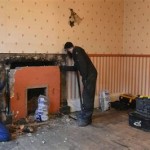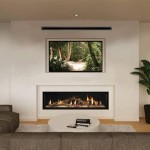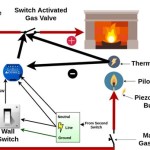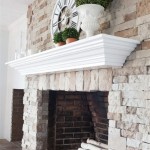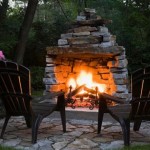Understanding Common Fireplace Parts Names
A fireplace is a complex system designed to safely contain fire and vent combustion byproducts out of a structure. Understanding the names and functions of the various components that comprise a fireplace is essential for proper maintenance, troubleshooting, and safe operation. This article details many of the common parts found in both traditional masonry fireplaces and prefabricated fireplace inserts, clarifying their roles within the system.
The specific components found in a fireplace vary depending on the type and age of the installation. Masonry fireplaces, built on-site, often have a more extensive range of parts compared to manufactured fireplace inserts, which are typically self-contained units. However, both types share some fundamental components necessary for safe and efficient operation.
The Firebox and Its Components
The firebox is the heart of the fireplace, the enclosed area where the fire is built. It is constructed of fire-resistant materials designed to withstand the extreme temperatures generated during combustion. Several key components reside within or directly influence the firebox.
Firebrick lines the interior of the firebox. These specialized bricks are made to withstand high temperatures without cracking or degrading. They protect the surrounding masonry from the direct heat of the fire. Over time, firebrick can crack or crumble and should be replaced to maintain the integrity of the firebox.
The Grate is a metal structure, typically made of cast iron or steel, that sits within the firebox and elevates the firewood. This elevation allows air to circulate beneath the wood, promoting more complete and efficient combustion. Different grate designs exist, with some optimized for specific types of wood or burning practices.
Andirons are decorative metal supports that sit on the hearth within the firebox. Similar to a grate, they elevate the wood, providing airflow. Andirons often serve an aesthetic purpose in addition to their functional one. They are most commonly found in traditional masonry fireplaces.
Damper: While not strictly *in* the firebox, the damper is directly connected. Usually located just above the firebox in the throat of the fireplace, the damper regulates the airflow through the chimney. When open, it allows smoke and combustion gases to escape. When closed, it prevents drafts from entering the room when the fireplace is not in use. A malfunctioning damper can significantly reduce fireplace efficiency and increase the risk of backdrafting.
The Chimney and Venting System
The chimney is a vertical shaft that vents the smoke and combustion gases from the firebox to the outside atmosphere. Its design is crucial for ensuring proper draft and preventing dangerous gases from entering the living space. The chimney is made up of several important parts.
The Flue is the interior lining of the chimney. It is typically made of clay tiles, metal, or cast-in-place concrete. The flue liner protects the chimney masonry from the corrosive effects of combustion byproducts, such as creosote. Damage to the flue liner can compromise the structural integrity of the chimney and increase the risk of fire. Regular inspections are crucial to identify cracks or deterioration in the flue.
The Chimney Crown sits at the top of the chimney and serves as a protective cap. It is usually constructed of concrete or metal and shields the chimney masonry from rain, snow, and other weather elements. A damaged chimney crown can allow water to penetrate the chimney, leading to deterioration and costly repairs.
The Chimney Cap is a mesh or solid structure that sits on top of the chimney crown. It prevents rain, snow, animals, and debris from entering the chimney. A chimney cap is an essential safety feature that also helps prevent downdrafts and improves draft efficiency. Some chimney caps include spark arrestors, which further reduce the risk of fire by preventing embers from escaping the chimney.
External and Accessory Fireplace Components
Beyond the core components of the firebox and chimney, several other parts contribute to the functionality and aesthetics of the fireplace.
The Hearth is the non-combustible area in front of the firebox. It provides a safe space for embers or sparks that may escape the firebox and protects the surrounding flooring from heat damage. Hearths are typically made of brick, stone, tile, or other fire-resistant materials. The size and material of the hearth are often dictated by building codes to ensure adequate fire safety.
The Fireplace Surround is the decorative facing around the firebox opening. It can be made of various materials, including wood, stone, brick, or metal. The surround serves primarily as an aesthetic element, enhancing the overall appearance of the fireplace. However, it can also provide some insulation and protection to the surrounding wall.
The Mantel is a decorative shelf that sits above the fireplace opening. It is often used to display decorative items or family photos. Mantels are typically made of wood, stone, or other materials. Building codes often specify minimum clearances between the mantel and the firebox opening to prevent overheating and potential fire hazards.
Mesh Screen or Glass Doors are safety features that cover the firebox opening. They prevent sparks and embers from escaping into the room. Mesh screens provide basic protection while allowing airflow. Glass doors offer more complete protection and can improve fireplace efficiency by controlling airflow and retaining heat. However, glass doors must be properly vented to prevent overheating.
Understanding these fireplace parts names and functions provides a foundation for effective fireplace maintenance and troubleshooting. Proper maintenance ensures safe and efficient fireplace operation. Regular inspections and timely repairs can prevent costly damage and reduce the risk of fire or other hazards.

What Are The Components Of A Fireplace Five Ways Fires

Getting To Know Your Fireplace Waterloo Kitchener Fireplaces Custom Cabinetry

Fireplace Terms

Concrete Fireplace Mantels Parts Design Reface

Result For Fireplace Parts Shiplap Feature Wall Mantel Surrounds Remodel

Get Fired Up Transform Your Fireplace Homesquare

Parts Of A Gas Fireplace Explained With Real Examples

Parts Of A Fireplace Chimney Explained With Diagrams And Real S

Soliftec Dictionary

Parts Of A Fireplace Chimney Explained With Diagrams And Real S
Related Posts

